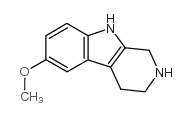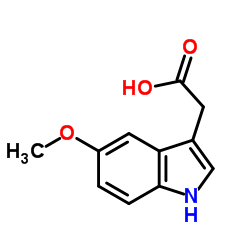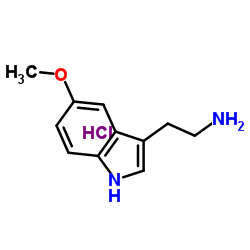20315-68-8
| 中文名 | 2,3,4,9-四氢-6-甲氧基-1H-吡咯[3,4-B]吲哚 |
|---|---|
| 英文名 | 6-methoxy-2,3,4,9-tetrahydro-1H-pyrido[3,4-b]indole |
| 中文别名 |
2,3,4,9-四氢-6-甲氧基-1H-吡啶并[3,4-B]吲哚
6-甲氧基-1,2,3,4-四氢-9H-吡啶并[3,4-B]吲哚 6-甲氧基-1,2,3,4-四氢-β-咔啉 |
| 英文别名 |
MFCD00012071
6-methoxytryptoline 6-Methoxy-1,2,3,4-tetrahydro-9H-pyrido[3,4-b]indole 6-MeOthbc |
| 密度 | 1.198 g/cm3 |
|---|---|
| 沸点 | 388.6ºC at 760 mmHg |
| 熔点 | 219-222ºC(lit.) |
| 分子式 | C12H14N2O |
| 分子量 | 202.25200 |
| 闪点 | 188.8ºC |
| 精确质量 | 202.11100 |
| PSA | 37.05000 |
| LogP | 2.15100 |
| 外观性状 | 黄褐色光敏固体 |
| 蒸汽压 | 3.03E-06mmHg at 25°C |
| 折射率 | 1.639 |
| 储存条件 | 密闭,阴凉,干燥处 |
| 稳定性 | 按规定使用和贮存的不会分解,避氧化物、光 |
| 计算化学 | 1.疏水参数计算参考值(XlogP):1.5 2.氢键供体数量:2 3.氢键受体数量:2 4.可旋转化学键数量:1 5.互变异构体数量:无 6.拓扑分子极性表面积37 7.重原子数量:15 8.表面电荷:0 9.复杂度:234 10.同位素原子数量:0 11.确定原子立构中心数量:0 12.不确定原子立构中心数量:0 13.确定化学键立构中心数量:0 14.不确定化学键立构中心数量:0 15.共价键单元数量:1 |
| 更多 | 1. 性状:白色固体 2. 密度(g/mL25 ºC):未确定 3. 相对蒸汽密度(g/mL,空气=1):未确定 4. 熔点(ºC):219-222 5. 沸点(ºC,常压):未确定 6. 沸点(ºC,0.87hPa):未确定 7. 折射率:未确定 8. 闪点(ºF):未确定 9. 比旋光度(º):未确定 10. 自燃点或引燃温度(ºC):未确定 11. 蒸气压(mmHg,20 ºC):未确定 12. 饱和蒸气压(kPa,60ºC):未确定 13. 燃烧热(KJ/mol):未确定 14. 临界温度(ºC):未确定 15. 临界压力(KPa):未确定 16. 油水(正辛醇/水)分配系数的对数值:未确定 17. 爆炸上限(%,V/V):未确定 18. 爆炸下限(%,V/V):未确定 19. 溶解性:未确定 |
|
Section1. IDENTIFICATION OF THE SUBSTANCE/MIXTURE Product identifiers Product name: 6-Methoxy-1,2,3,4-tetrahydro-9H-pyrido[3,4-b]indole CAS-No.: 20315-68-8 Relevant identified uses of the substance or mixture and uses advised against Identified uses: Laboratory chemicals, Manufacture of substances Section2. HAZARDS IDENTIFICATION Classification of the substance or mixture Classification according to Regulation (EC) No 1272/2008 [EU-GHS/CLP] Skin irritation (Category 2) Eye irritation (Category 2) Specific target organ toxicity - single exposure (Category 3) Classification according to EU Directives 67/548/EEC or 1999/45/EC Irritating to eyes, respiratory system and skin. Label elements Labelling according Regulation (EC) No 1272/2008 [CLP] Pictogram Signal wordWarning Hazard statement(s) H315Causes skin irritation. H319Causes serious eye irritation. H335May cause respiratory irritation. Precautionary statement(s) P261Avoid breathing dust/ fume/ gas/ mist/ vapours/ spray. P305 + P351 + P338IF IN EYES: Rinse cautiously with water for several minutes. Remove contact lenses, if present and easy to do. Continue rinsing. Supplemental Hazardnone Statements According to European Directive 67/548/EEC as amended. Hazard symbol(s) R-phrase(s) R36/37/38Irritating to eyes, respiratory system and skin. S-phrase(s) S26In case of contact with eyes, rinse immediately with plenty of water and seek medical advice. S36Wear suitable protective clothing. Other hazards - none Section3. COMPOSITION/INFORMATION ON INGREDIENTS Substances Synonyms: 6-Methoxy-1,2,3,4-tetrahydro-9H-pyrido[3,4-b]indole 6-Methoxy-1,2,3,4-tetrahydro-β-carboline Formula: C12H14N2O Molecular Weight: 202,25 g/mol ComponentConcentration 6-Methoxy-1,2,3,4-tetrahydro-9H-pyrido[3,4-b]indole CAS-No.20315-68-8- Section4. FIRST AID MEASURES Description of first aid measures General advice Consult a physician. Show this safety data sheet to the doctor in attendance. If inhaled If breathed in, move person into fresh air. If not breathing, give artificial respiration. Consult a physician. In case of skin contact Wash off with soap and plenty of water. Consult a physician. In case of eye contact Rinse thoroughly with plenty of water for at least 15 minutes and consult a physician. If swallowed Never give anything by mouth to an unconscious person. Rinse mouth with water. Consult a physician. Most important symptoms and effects, both acute and delayed To the best of our knowledge, the chemical, physical, and toxicological properties have not been thoroughly investigated. Indication of any immediate medical attention and special treatment needed no data available Section5. FIREFIGHTING MEASURES Extinguishing media Suitable extinguishing media Use water spray, alcohol-resistant foam, dry chemical or carbon dioxide. Special hazards arising from the substance or mixture Carbon oxides, nitrogen oxides (NOx) Advice for firefighters Wear self contained breathing apparatus for fire fighting if necessary. Further information no data available Section6. ACCIDENTAL RELEASE MEASURES Personal precautions, protective equipment and emergency procedures Use personal protective equipment. Avoid dust formation. Avoid breathing vapors, mist or gas. Ensure adequate ventilation. Evacuate personnel to safe areas. Avoid breathing dust. Environmental precautions Do not let product enter drains. Methods and materials for containment and cleaning up Pick up and arrange disposal without creating dust. Sweep up and shovel. Keep in suitable, closed containers for disposal. Reference to other sections For disposal see section 13. Section7. HANDLING AND STORAGE Precautions for safe handling Avoid contact with skin and eyes. Avoid formation of dust and aerosols. Provide appropriate exhaust ventilation at places where dust is formed.Normal measures for preventive fire protection. Conditions for safe storage, including any incompatibilities Store in cool place. Keep container tightly closed in a dry and well-ventilated place. Light sensitive. Specific end uses no data available Section8. EXPOSURE CONTROLS/PERSONAL PROTECTION Control parameters Components with workplace control parameters Exposure controls Appropriate engineering controls Handle in accordance with good industrial hygiene and safety practice. Wash hands before breaks and at the end of workday. Personal protective equipment Eye/face protection Safety glasses with side-shields conforming to EN166 Use equipment for eye protection tested and approved under appropriate government standards such as NIOSH (US) or EN 166(EU). Skin protection Handle with gloves. Gloves must be inspected prior to use. Use proper glove removal technique (without touching glove's outer surface) to avoid skin contact with this product. Dispose of contaminated gloves after use in accordance with applicable laws and good laboratory practices. Wash and dry hands. The selected protective gloves have to satisfy the specifications of EU Directive 89/686/EEC and the standard EN 374 derived from it. Body Protection impervious clothing, The type of protective equipment must be selected according to the concentration and amount of the dangerous substance at the specific workplace. Respiratory protection For nuisance exposures use type P95 (US) or type P1 (EU EN 143) particle respirator.For higher level protection use type OV/AG/P99 (US) or type ABEK-P2 (EU EN 143) respirator cartridges. Use respirators and components tested and approved under appropriate government standards such as NIOSH (US) or CEN (EU). Section9. PHYSICAL AND CHEMICAL PROPERTIES Information on basic physical and chemical properties a) AppearanceForm: solid Colour: white b) Odourno data available c) Odour Thresholdno data available d) pHno data available e) Melting point/freezingMelting point/range: 219 - 222 °C - lit. point f) Initial boiling point and no data available boiling range g) Flash pointno data available h) Evaporation rateno data available i) Flammability (solid, gas) no data available j) Upper/lowerno data available flammability or explosive limits k) Vapour pressureno data available l) Vapour densityno data available m) Relative densityno data available n) Water solubilityno data available o) Partition coefficient: n- no data available octanol/water p) Autoignitionno data available temperature q) Decompositionno data available temperature r) Viscosityno data available s) Explosive propertiesno data available t) Oxidizing propertiesno data available Other safety information no data available Section10. STABILITY AND REACTIVITY Reactivity no data available Chemical stability no data available Possibility of hazardous reactions no data available Conditions to avoid no data available Incompatible materials Strong oxidizing agents Hazardous decomposition products Other decomposition products - no data available Section11. TOXICOLOGICAL INFORMATION Information on toxicological effects Acute toxicity no data available Skin corrosion/irritation no data available Serious eye damage/eye irritation no data available Respiratory or skin sensitization no data available Germ cell mutagenicity no data available Carcinogenicity IARC:No component of this product present at levels greater than or equal to 0.1% is identified as probable, possible or confirmed human carcinogen by IARC. Reproductive toxicity no data available Specific target organ toxicity - single exposure Inhalation - May cause respiratory irritation. Specific target organ toxicity - repeated exposure no data available Aspiration hazard no data available Potential health effects InhalationMay be harmful if inhaled. Causes respiratory tract irritation. IngestionMay be harmful if swallowed. SkinMay be harmful if absorbed through skin. Causes skin irritation. EyesCauses serious eye irritation. Signs and Symptoms of Exposure To the best of our knowledge, the chemical, physical, and toxicological properties have not been thoroughly investigated. Additional Information RTECS: UV0725000 Section12. ECOLOGICAL INFORMATION Toxicity no data available Persistence and degradability no data available Bioaccumulative potential no data available Mobility in soil no data available Results of PBT and vPvB assessment no data available Other adverse effects no data available Section13. DISPOSAL CONSIDERATIONS Waste treatment methods Product Offer surplus and non-recyclable solutions to a licensed disposal company. Contact a licensed professional waste disposal service to dispose of this material. Dissolve or mix the material with a combustible solvent and burn in a chemical incinerator equipped with an afterburner and scrubber. Contaminated packaging Dispose of as unused product. Section14. TRANSPORT INFORMATION UN number ADR/RID: -IMDG: -IATA: - UN proper shipping name ADR/RID: Not dangerous goods IMDG: Not dangerous goods IATA:Not dangerous goods Transport hazard class(es) ADR/RID: -IMDG: -IATA: - Packaging group ADR/RID: -IMDG: -IATA: - Environmental hazards ADR/RID: noIMDG Marine pollutant: noIATA: no Special precautions for user no data available SECTION 15 - REGULATORY INFORMATION N/A SECTION 16 - ADDITIONAL INFORMATION N/A |
CHEMICAL IDENTIFICATION
HEALTH HAZARD DATAACUTE TOXICITY DATA
|
| 符号 |

GHS07 |
|---|---|
| 信号词 | Warning |
| 危害声明 | H315-H319-H335 |
| 警示性声明 | P261-P305 + P351 + P338 |
| 个人防护装备 | dust mask type N95 (US);Eyeshields;Gloves |
| 危害码 (欧洲) | Xi: Irritant; |
| 风险声明 (欧洲) | R36/37/38 |
| 安全声明 (欧洲) | 26-36 |
| 危险品运输编码 | NONH for all modes of transport |
| RTECS号 | UV0725000 |
|
~94% 
20315-68-8 |
| 文献:Pellegrini; Strassler; Weber; Borschberg Tetrahedron Asymmetry, 1994 , vol. 5, # 10 p. 1979 - 1992 |
|
~% 
20315-68-8 |
| 文献:Bioorganic and Medicinal Chemistry Letters, , vol. 16, # 22 p. 5840 - 5843 |
|
~% 
20315-68-8 |
| 文献:Bioorganic and Medicinal Chemistry Letters, , vol. 13, # 24 p. 4421 - 4425 |
|
~% 
20315-68-8 |
| 文献:Bioorganic and Medicinal Chemistry Letters, , vol. 16, # 22 p. 5840 - 5843 |
|
~% 
20315-68-8 |
| 文献:Journal of the Chemical Society, , p. 4589,4591 |
|
~% 
20315-68-8 |
| 文献:Pharmaceutical Chemistry Journal, , vol. 17, # 8 p. 559 - 563 Khimiko-Farmatsevticheskii Zhurnal, , vol. 17, # 8 p. 936 - 940 |
|
~% 
20315-68-8 |
| 文献:Acta Chemica Scandinavica, Series B: Organic Chemistry and Biochemistry, , vol. 39, # 10 p. 849 - 860 |
| 上游产品 7 | |
|---|---|
| 下游产品 0 | |








